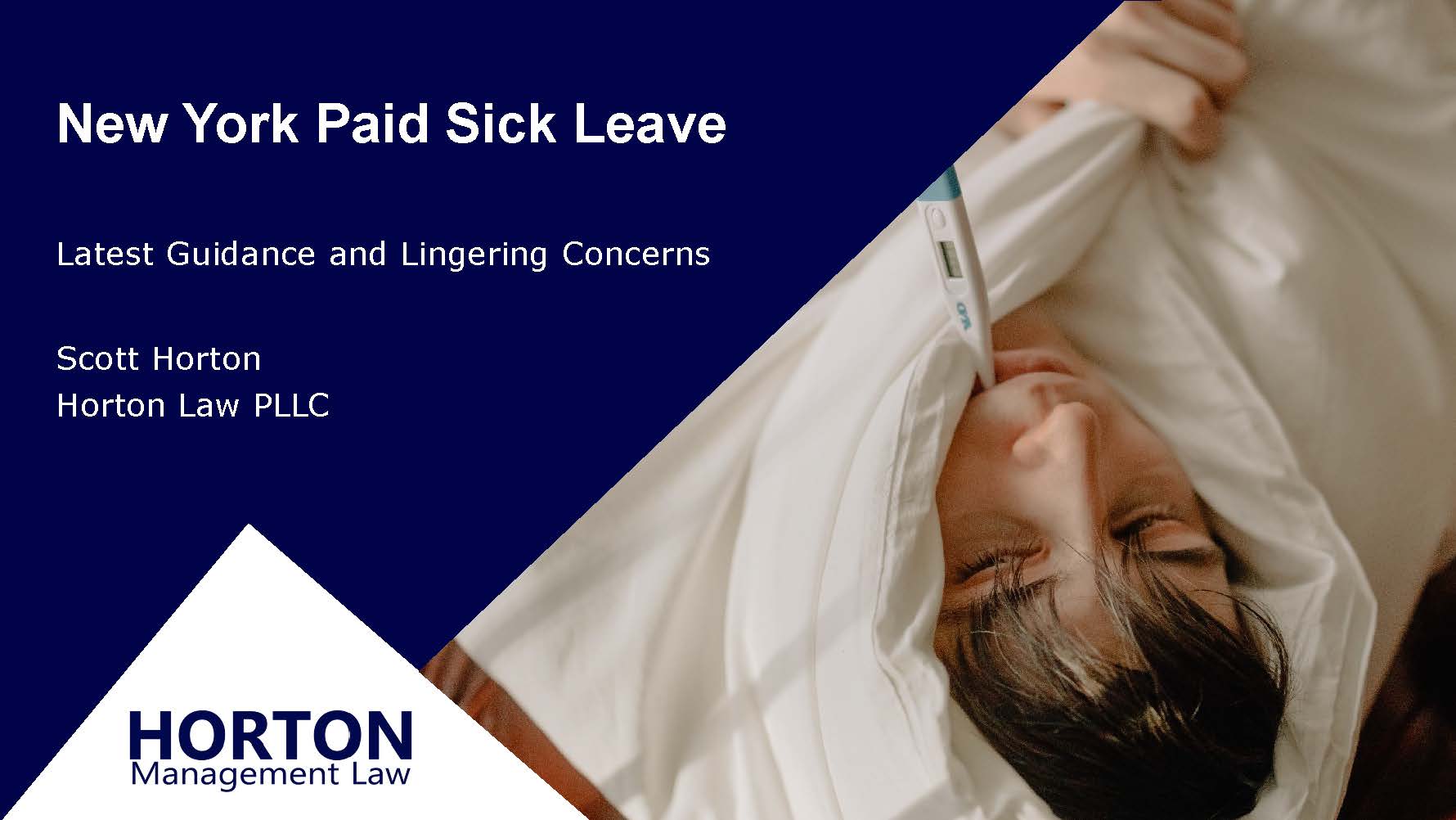On December 22, 2021, the New York State Department of Labor adopted final regulations regarding the New York State Paid Sick Leave Law. The DOL adopted the rules as originally proposed on December 9, 2020, with no changes. However, in giving notice of the final adoption of the NYS sick leave rules, the DOL responded to many comments it had received on the proposed rules.
While still leaving many concerns unresolved, the DOL has provided some additional guidance to employers. Here’s a look at several key issues the DOL reviewed.
Carry Over
The New York Paid Sick Leave Law provides that employees can carry over unused sick leave from one year to the next. But it also permits employers to limit their employees’ use of sick leave to the statutory level (40 or 56 hours based on employer size) each year. Consequently, many employees will accrue sick leave that they’d never be eligible to use.
Especially where employers frontload sick leave meeting or exceeding the annual statutory requirement, the carryover requirement is at least a pointless administrative hassle. But it creates more tangible trouble in some cases, including situations where employers include sick leave with other forms of paid leave. This leave aggregation is permissible under the sick leave law. However, the law then seemingly requires that all such paid leave time must be carried over from year to year if unused, even where, as is often the case, the annual paid time off allowance exceeds the statutory sick leave mandate.
The DOL responded directly to three related carry-over questions. Unfortunately, their responses don’t offer much relief to employers struggling with the administrative or substantive mischief the carry-over conundrum can create. The DOL went further to emphasize the significance of the statutory carryover provision: “While the Department understands there may be occasional conflicts between an employer’s existing leave policies and the statute, the statute permits such alternative compliance so long as the standards set in the accrual, use, and carryover provisions are met”. Ironically, the DOL otherwise notes the potential benefits of frontloading sick leave “to avoid added complexity” in calculating leave accrual.
The DOL has found room to allow employers the option to let employees cash out some of their unused sick leave at the end of the year rather than carry it over to the next year.
Employee Rights
The DOL responded to two suggestions under this heading. One seemingly sought to restrict employee rights to use sick time. Another sought to expand on employee protections.
One commenter wanted to prevent new employees from using sick leave immediately upon accrual, fearing the risk of sick leave abuse. The DOL indicated that the law would not permit such a limitation.
Another commenter wanted the rules to include information on employees’ ability to file complaints and be free from retaliation for exercising their rights to use sick leave. The DOL noted that such provisions are already otherwise established by law.
In response to another comment (listed under “Other Leave Usage”), the DOL offered the general assertion that “The Department declines to opine on any potential conflict with existing state or federal statutes, apart from asserting that none are believed to exist.”
Collective Bargaining Agreements
The DOL made one response to comments on the NYS sick leave rules specifically addressing unionized workplaces. The DOL dismissed all comments seeking specific direction related to collective bargaining agreements because “These comments are outside the scope of this rulemaking, which does not directly address CBAs.” Not particularly helpful.
Employee Count
On the other hand, while finding the issue not to be “addressed in this rulemaking,” the DOL nonetheless offered its interpretation that employer coverage under the NYS Paid Sick Leave Law is based on their total U.S. employee count. In other words, not only employees working in New York.
The DOL offered no revision in response to comments on the rule requiring employers to count the highest number of concurrently employed employees. However, it indicated that it “may provide additional guidance for clarity as necessary.”
The DOL declined to address joint employer situations. Instead, it deferred to “existing and settled law.”
Documentation and Attestations
In response to commenters’ suggestions, the DOL indicated it will produce a template for employee attestations.
The agency also warns employers to be cautious when questioning sick leave usage: “An employer may not deny an employee leave while attempting to confirm the basis for the leave. If, however, the employer discovers the request to be false or fraudulent, disciplinary action may be taken against the employee”. The DOL goes on to warn of potential retaliation claims for improperly denying leave or disciplining employees who take it. There is also clarification that even when an employer fears abuse, it may not require documentation for leave less than three days.
The DOL also “declines to create a separate notice requirement for foreseeable leave.”
Notice to Employees
Commenters suggested that the DOL’s NYS sick leave rules include a requirement that employers provide notice of the law’s requirements to employees. The DOL declined to impose such an obligation on employers.
Payment Issues
In response to a comment for clarification of when employers must pay for used sick leave, the DOL confirmed that failing to pay sick leave is “equivalent to a failure to pay employee wages.”
The DOL likewise declined to amend the NYS sick leave rules to define the regular rate of pay. Instead, it offered that “Methods for determining the employee’s regular rate of pay already exists within the Labor Law, the regulations of the Department of Labor, relevant case law, and guidance.”
Overall Message to Employers
Not so subtly, the DOL’s commentary on the adoption of the NYS sick leave rules conveys a refusal to revisit the subject meaningfully. Among other assertions, the DOL dismissively asserts, “The current guidance and FAQs are sufficient in the areas referenced [by commenters] and as such topics are outside of the scope of the rule, no further response is appropriate.” It is disappointing that the DOL chooses to knowingly leave its guidance out of formal rulemaking in favor of addressing it in casual documents with significantly less legal weight. As such, employers are left with various compliance dilemmas in addition to the underlying cost of providing paid leave. It’s even more frustrating that the law complicates leave policies for employers who were already offering more paid time off than the law requires.
For more legal updates of interest to New York employers, follow Horton Law on LinkedIn.




You must be logged in to post a comment.